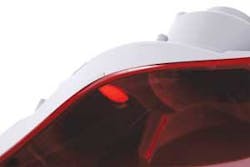Hybrid laser welding of polymers
René Geiger, Oliver Brandmayer, and Frank BrunneckeR LPKF Laser & Electronics AG
The combination of laser radiation with radiation emitted by halogen lamps provides improvements over the conventional laser welding process
Most plastic welding systems sold today involve machinery that employs either friction or hot-plate welding technology.1 These systems involve a contacting operation of an application-specific tool with the workpiece, causing either high mechanical loads on the workpiece or material partially adhering to the tool. If these deficiencies are decisive critera in the choice of a joining method, a contactless transmission welding technology using infrared radiation promises to be an interesting alternative approach. In this variant of radiation welding, the laser energy penetrates the overlapping top layer and passes through to the joint zone, where it is absorbed by the lower part. Thermal conduction, promoted by clamping pressure, into the transmitting partner also leads to local plasticization of the polymer and ultimately to positive-type joints (see Figure 1).
The first implementation of this principle dates back before the 1970s when incandescent lamps were employed as a source of radiation.2 Due to the low levels of irradiance obtained from such lamps, the attainable feed rates were limited to only a few millimeters.3
In the 1990s, transmission welding using lasers as a source of radiation was found to be especially suitable for welding electronic housings.4 The highly controllable energy deposition into the material combined with a satisfactory beam intensity contributed to an increase in the stability and efficiency of the welding process. Although various efforts have been taken to extend laser transmission welding to large, complex-shaped contours, no such application has been published until now because the necessity of a permanent thermal contact imposes restrictions, as larger injection-molded parts can present higher geometrical deviations that need to be compensated.
An approach to overcome this limitation is hybrid welding of polymers, where a semiconductor laser and a secondary source of radiation, for example a halogen lamp, simultaneously provide the laser beam energy being deposited into the material. Thus, the required laser power and the costs for the laser beam source can be reduced. The hybrid welding technology has been developed by LPKF Laser & Electronics AG, Plastics Welding Div., Erlangen, in cooperation with the Institut Bayerisches Laserzentrum GmbH.
Hybrid welding
Hybrid welding combines the advantages of laser welding, referred to as “primary radiation,” and infrared welding with halogen lamps, referred to as “secondary radiation.” A big challenge is to combine the primary radiation and the secondary radiation in one focal point. The primary radiation, generated by a diode laser, is focused by common optical elements such as fibers and lenses.
Focusing the secondary radiation is achieved by putting the lamp filament into one focal point of an ellipsoidal reflector with its second focal point coinciding with the welding plane and the focus of primary radiation (see Figure 2). Because the secondary radiation is non-coherent, a short working distance between the welding seam and the lamp filament is important, so that a maximum level of energy can be achieved at the focal point. The inclined alignment of the ellipsoidal reflectors causes the secondary radiation to be spread over a larger, elliptical cone section compared to the circular focus at perpendicular incidence. The minimal angle of incidence β is limited by the space required for the reflectors. The maximum potential intensity reached is 81%. The total maximum level of irradiance of secondary radiation is obtained by a superposition of all three sources. The spot diameter that can be obtained from this configuration has been measured to be ~6–8mm.
A hybrid welding head for use in industrial operations includes a halogen reflector, laser optics, and a clamping tool (see Figure 3). A robot arm moves this hybrid welding head along a complex three-dimensional contour.
The process
Monochromatic laser radiation at typical diode laser wavelengths between 808 and 980nm passes through a 2mm-thick polycarbonate specimen without being substantially affected. The heat affected zone (HAZ) is located at the absorbing joining partner. Previous investigations have shown that the strength of the weld seam increases with the depth of molten polymer in the transmissive layer.5
An extended HAZ in the upper joining partner using the hybrid welding process is caused by heat conduction and the volumetric heating by secondary radiation. A further advantage results from the different interaction of both types of radiation with light-scattering inclusions in the polymer, such as crystallites in semi-crystalline polymers or commonly used reinforcing glass fibers. The scattering that takes place in the semi-crystalline polymer homogenizes the secondary beam instead of attenuating it. Nevertheless, the absolute level of irradiance is still higher at the employed laser radiation than at the secondary radiation by an order of magnitude.
Results
Sample specimens (40 x 20 x 2mm3) made from black and natural polycarbonate have been welded in an overlapping T-like alignment. The seam strength has been measured by conventional tensile testing, with the seam area being limited to 80mm2 by the thickness and the length of the absorbing joining partner. If a broadening of the seam occurred due to a deformation of the absorbing sample specimen at high rates of energy input, it has been taken into consideration while calculating the figures presented below.6Figure 4 is a comparison of the tensile strength observed with a conventional laser welding process. The process used a laser power of 5W with a hybrid welding process that additionally employed 160W of secondary radiation.
Both processes are carried out with the hybrid welding system described previously. Shifting the maximally attainable tensile strength to higher feed rates can be expected due to the secondary radiation that is superimposed to the laser radiation. Remarkably, the process has been accelerated four times, whereas the total level of irradiance has only been raised by ~50%. Additionally, a higher maximum tensile strength can be observed at the hybrid welding process.
Because of the existing tolerances of injection molded parts, it is necessary to provide a maximum gap-binding capability of the welding process. In order to figure out the possibility of gap-binding, samples are prepared with different gap depth. The length of the gap is 50% of the whole seam length. With the hybrid welding process, it is possible to reach seam strength of 71% with a gap depth of 0.2mm. Higher gap depths prevent a compound of the joining partners. Using a conventional laser welding process, a gap-bridging is impossible at deeper gaps than 0.1mm. By using a clamping device together with hybrid welding, a gap-bridging of 0.4mm-deep gaps is achievable.
Cracks result from residual stresses caused by the cooling of the welding seam. To reduce residual stresses welded parts are often tempered after the joining process. Figure 5 shows sectional views of the welding seam after five minutes dipping in a solvent. It is obvious that hybrid welding reduces residual stress enormously. Tempering after the welding process is no longer required.
Application
One application for hybrid laser welding of plastic parts is sealed joints of tail lights for motor vehicles. Conventional joint technologies such as adhering or vibration welding are often adverse so that joint lines have to be concealed to cover visually unsightly joint areas.
Alternate laser welding procedures for three-dimensional plastic components have been compared with hybrid welding in a benchmark test by a South Korean automotive supplier, doing various tests with tail lights. The result: hybrid welding meets the requirements in terms of optical appealing joint lines and a high firmness of the joint lines at highest process rates. The tail light housing had to be joined together with the cover glass to produce a visually appealing joint line.
The housing of the tail light is made from polymethylmethacrylate (PMMA) colored with black, grey, and red pigments. The material for the lens is clear or red colored polycarbonate (PC). All colors have to be welded with the same welding equipment. The length of the weld seam is ~1000mm. To achieve an equal weld seam quality along the complete welding contour, it was necessary to make small modifications in the design of the rear lamp. For example the stiffness of the housing was increased to avoid a movement of the housing during clamping.
The combination of a clamping finger and sequential clamping technology (see Figure 6) showed the best results, while introducing the clamping pressure. The exclusive use of a clamping finger is not possible due to the default design. The tail light’s acute angle is less than 45°, therefore, to draft the clamping finger to the lens is impossible during welding the outer edge of the tail light.
The welded tail lights excel in a visually appealing joint line and a high steady monotone quality. There is no blistering in the melt throughout the whole joint line length (see Figure 7).
The process speed of hybrid laser welding is approximately five times higher than using a conventional laser welding process with a higher joint strength. The tail light can be welded within 30 sec, independent of the coloring of the absorbing joint partner without a following thermal treatment to avoid internal stress.
Conclusion
Conventional laser transmission welding has proven to generate weld seams with a reliably high tensile strength. Extending the range of applications of this welding method on large, complexly shaped three-dimensional parts is still missing. The combination of laser radiation with radiation emitted by halogen lamps provides improvements over the conventional laser welding process: twice the feed rate without any loss of seam strength at maximum reachable tensile strength. Because of the extended process window, the higher gap-binding ability, and less residual stresses, the welding process is more stable. ¿
The authors are all with LPKF Laser & Electronics AG, Erlangen, Germany (www.laserequipment.com). Contact them at [email protected].
References
- F. Becker, “Einsatz des Laserdurchstrahlschweiβens zum Fügen von Thermoplasten,” Dissertation, Aachen: Shaker, 2003.
- D. Grewell, “Applications with Infrared Welding of Thermoplastics,” ANTEC ’99 Conference Proc. Vol. 1, Brookfield, CT, SPE, pp. 1411-1415, 1999.
- H.-J. Yeh, R. Grimm, “Infrared Welding of Thermoplastics: Characterization of Transmission Behaviour of Eleven Thermoplastics,” ANTEC ’98 Conference Proceedings, Vol. 1, Brookfield, CT, SPE, pp. 1030-1033, 1998.
- S. Hierl, M. Geiger, K. Lenfert, R. Baur, R. Luchs, J. Mahrle, “Laserstrahlkunststoffschweiβen in der Automobilelektronik,” M. Geiger, A. Otto, (Eds.): Laser in der Elektronik und Feinwerktechnik LEF 2000, Bamberg: Meisenbach, pp. 53-68, 2000.
- D. Haensch, “Die optischen Eigenschaften von Polymeren und ihre Bedeutung für das Durchstrahlschweiβen mit Diodenlasern,” Dissertation, Aachen: Shaker, 2001.
- A. Hofmann, T. Frick, M. Geiger, “Hybrid Laser Welding of Polymers,” M. Geiger, A. Otto, (Eds): Laser Assisted Net Shape Engineering 4, Vol. 1, Bamberg: Meisenbach, pp. 293-304, 2004.







